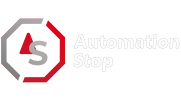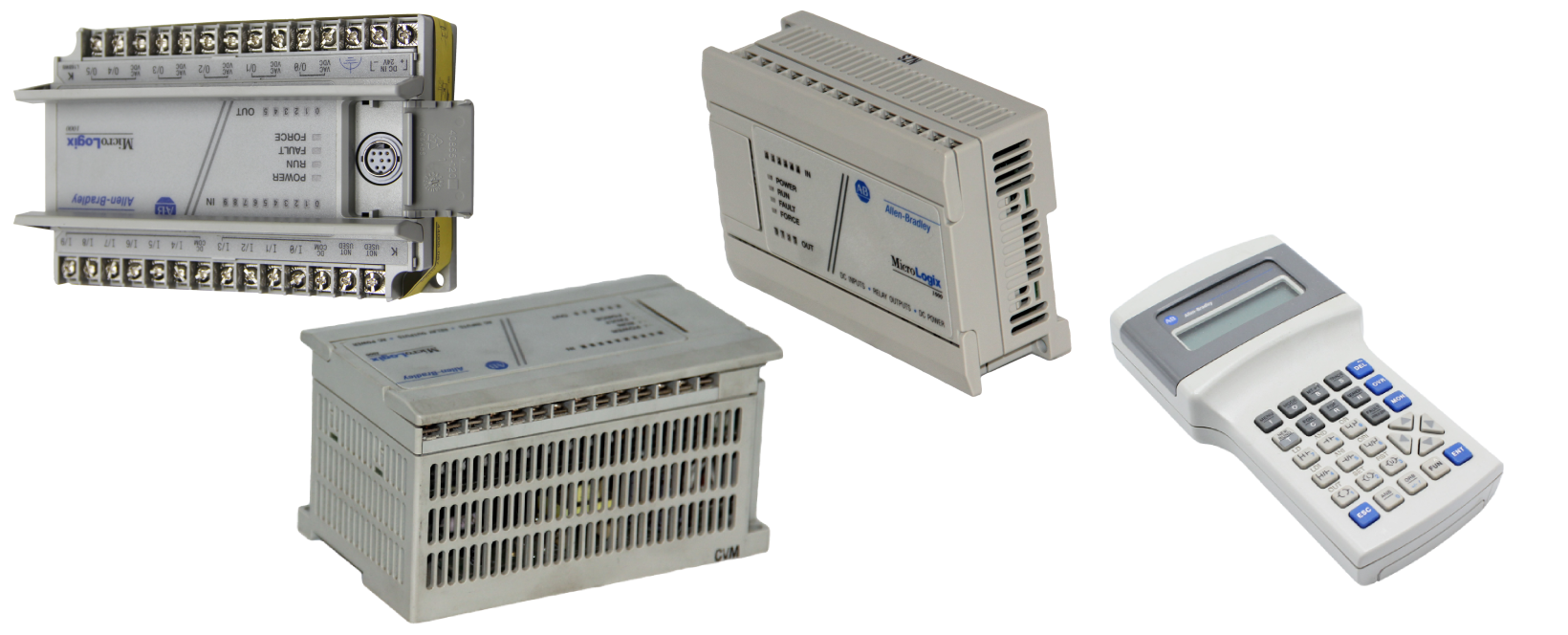MicroLogix 1000 Selection Guide
MicroLogix 1000 is a compact but inexpensive module that offers control solutions for a wide range of applications. The MicroLogix 1000 controller, produced by Allen Bradley, is a Programmable Logic Controller (PLC). This controller offers fast instructions with a flexible and reliable communication strategy for all those applications which need space-efficient controllers to perform the task. This controller is available in 17 different models with a varying number of I/O configurations, packaging size, permissible input voltage range, the capability to withstand inrush current, and so much more.
Hardware Features
The MicroLogix 1000 controller has input pins (analog and digital) to attach input devices, such as sensors or push button-based controllers, to give directions. Signals or directions are processed by the central processing unit (CPU) within the module. Output pins are attached to any device to be controlled (e.g., motor starter) or to show indications (e.g., LEDs). Moreover, this controller module has a built-in power supply, input LEDs, output LEDs, status LEDs, and communication channels.
There are many more important hardware features of the MicroLogix 1000 controller. These hardware features include:
Input Channels
Depending on the model, a MicroLogix 1000 controller module could have a 10 I/O point, 16 I/O point, or 32 I/O point configuration in digital mode. Some models of this series also have analog versions with a 16-bit resolution capable of detecting current, within a range of -21 to +21 milliamperes, as well as voltage input ranging from -10.5 volts to +10.5 volts. Voltage input pins have overvoltage protection of 24VDC. Current input pins have overcurrent protection against a current rated at +/- 50mA.
This controller has multiple commons on the input side. Therefore, the input channels can be used as a source or a sink. By default, all input channels are enabled, and the user has the independence to enable or disable each channel individually.
Output Channels
The output channels of the MicroLogix 1000 controller have three different types, which include relay, MOSFET, and Triac. The maximum load current for Triac pins is 0.5A (amperes) per point at 55°C and 1A at 30°C, while for MOSFET pins, this limit becomes 1A and 1.5A, respectively. Similarly, the minimum load current for the relay, MOSFET, and Triac switch is 10 mA, 1 mA, and 10 mA, respectively. By default, all of the analog output channels are configured to give voltage as output, but any pin can also be made to provide current output. The output channels have an output voltage ranging from 0 to 10VDC and an output current ranging from 4 to 20mA. Moreover, the load range for analog voltage output pins is 1k ohm or above; and for that of current analog output pins, it is a maximum of 500 ohms.
The output pin panel also has different commons making this controller useful for applications where isolated output voltages are needed.
Memory
MicroLogix 1000 controllers have 1Kb (kilobyte) of preconfigured built-in memory, which is Electrically Erasable Programmable Read-only Memory (EEPROM). This memory module can store 737 instruction words or 437 data words. Through a Handheld Programmer (HHP), this memory module can be used for program transport or backup. An HHP will also help in editing, writing, monitoring, or debugging instruction lists in a program of MicroLogix 1000 controller.
An HHP has a memory module, a socket for the memory module, and a door for the memory module. For MicroLogix 1000 HHPs, there are two options for the installation of extra memory. First, a memory module of 8Kb can be used to optimally store one program. Second, a 64Kb memory module can be used to store a minimum of 8 programs.
Power Supply
As mentioned earlier, MicroLogix 1000 controllers come in 17 different models. These models have quite different types of power supplies built within their packaging. Broadly, these controllers are either powered by AC power supplies or DC power supplies. AC power supplies can be that of 85 to 264 VAC with frequencies ranging from 47 to 63Hz. DC power supplies of these types of controllers have a voltage range of 20.4 to 26.4 VDC. Power supplies designed for MicroLogix 1000 controllers can withstand power shutdowns for a limited time, also known as the hold-up time. After this time, the processor gets the signal that there is no provision of adequate power for now. The hold-up time for the power supplies of MicroLogix 1000 controllers ranges from 20 milliseconds to 3 seconds.
As far as power supply inrush current is needed, MicroLogix 1000 power supply can accept an inrush current provided by a power source. Anyhow, it doesn’t need it necessarily. To elaborate further, if there is a large-sized capacitor on the input side of the controller which is to be charged by the power supply, the power supply will charge it while taking its time. However, if the power source furnishes inrush current, then the capacitor will charge quite quickly in the starting phase.
Operating Conditions/Environmental Specifications
MicroLogix 1000 programmable controllers come in sturdy packaging, yet care must be taken to get the best out of them for a longer period. For this purpose, some environmental conditions and physical quantity parameters must remain in a defined range.
Operating Temperature Range
The permissible operating temperature range of MicroLogix 1000 controllers depends upon the model, as well as the mounting type. When a vertically mounted analog controller is operating, the temperature of the module must remain within a range of 0 to 40 degrees Celsius. However, the operating temperature of a vertically mounted discrete controller should remain within a range of 0 to 45 degrees Celsius. Furthermore, horizontally mounted MicroLogix 1000 controllers can operate well within a temperature window of 0 to 55 degrees Celsius.
Humidity and Storage Temperature Range
When in operation, MicroLogix 1000 controllers must be placed within an environment that has a non-condensing relative humidity of 5 to 95%. This controller must be stored in an environment where the temperature ranges from -40 to 85 degrees Celsius.
Communication Compatibility
MicroLogix 1000 controllers have RS-232 communication channels, which connect with its HHP through a serial cable. Specifically, these controllers support DH-485, as well as DF1 full and half-duplex slave protocols.
All analog controllers from MicroLogix 1000 series support the DH-485 communication network, while discrete controllers, from the series C or later models, also support DH-485 network communication. Allen-Bradley recommends using Belden 3106A or 9842 cables to establish DH-485 network communication. Different segments of the cable must be joined together in a daisy-chain fashion. These cables are shielded so electrostatic noise on the communication line could be minimized which would be present in an industrial environment.
When it comes to DF1, all analog controllers of this series support DF1 full, as well as half Duplex slave protocols. Among discrete controllers, DF1 Full-Duplex slave protocol is supported by all models of the MicroLogix 1000 series, while DF1 Half-Duplex slave protocol is only supported by series D or later models. Moreover, the DF1 Half Duplex slave protocol can’t be selected or configured by using MicroLogix 1000 Handheld Programmer (HHP).
MicroLogix 1000 controllers are capable of identifying the active protocol (DH-485 or DF1), making configurations automatically, and establishing the connection on their own. Anyhow, the user can give appropriate input to help establish the connection in a relatively shorter time.
The user of the MicroLogix 1000 controller has the liberty to connect the controller with a DeviceNet network by using DNI (DeviceNet Interface).
Electromagnetic Compatibility
MicroLogix 1000 controllers that are comprised of solid-state components are built to minimize Electromagnetic Interference (EMI). This product series meets many standards pertaining to Electromagnetic compatibility (EMC). For instance, it fulfills the criteria for Council Directive 89/336/EEC. As this equipment is targeted for use in industries, that’s why it is also made to be compatible with part 2 of EN50081 and EN50082, which pertain to the industrial environment.
Handheld Programmer
As mentioned earlier, a handheld programmer (HHP) is an integral part of MicroLogix 1000 controllers as it is used to modify, create, edit instructions in a program, and perform a range of other tasks, such as mode and function selection. For improved usability, it is equipped with a 2-line display LCD. Each line can display up to 16 characters. It needs just 2 watts of power to operate. This little accessory package can handle the shock of 50g peak acceleration when operating and not operating. This HHP can also withstand vibrations with a frequency of 10 to 500Hz.
It has many push buttons on its keypad to give instructions to the controller and perform tasks, such as troubleshooting, navigating through a program easily, or selecting functions like mode, program monitor, or data monitor.
Safety Features and Master Control Relay
The MicroLogix 1000 controller possesses several safety features. For instance, this module provides isolation from 1500 VAC to ensure protection for personnel, as well as other equipment in the surrounding. Moreover, this controller has some circuits from a protection point of view. These circuits are linked with overtravel limit switches, interlocks, and stop pushbuttons. All safety switches are wired in series so that the machine stops operating if any of the switches get opened.
The presence of a Master Control Relay (MCR) is one of the major hardware specifications for enhanced safety. This relay allows the user of the machine to make a direct connection between the emergency stop switch with the relay for extended protection. This allows its owner to install different emergency safety switches at different points.
Input Channel Filtering
Input channels have adjustable filters so users could vary the noise rejection capability and input response time of a channel suitable for their application. To make the analog input signal of a channel more immune to electrical noise, the user of the machine can make the filter slower. This will also make input updates slow but the input signal will not be affected. On the other hand, a faster analog input channel will be more prone to accepting electrical noise and distorting the signal. The accuracy of analog input channels can also be increased through software offset.
Instruction Sets
The application program for MicroLogix 1000 controllers has many instruction sets, which are used to perform different functions or to monitor the status of both the input and output pins. On a broader horizon, these instruction sets are divided into different categories for ease of use. These instruction sets include:
- Basic Instructions: These instructions operate on a single data bit and are mostly used for timing or counting operations, or relay replacement functions.
- Comparision Instructions: Simply put, these instructions are to make a comparison between pairs of values and the result is to provide a condition for continuity or discontinuity of a rung.
- Data Handling Instructions: These are output instructions that are used to perform logical operations, manipulate data, or convert information.
- Program Flow Control Instructions: This instruction set contains instructions like JMP (Jump to Label), LD LBL (Label), JSR (Jump to Subroutine), etc. This set also mostly has output instructions. Through these instructions, the sequence of execution of segments of a program is controlled.
- Application Specific Instructions: Instructions such as BSL (Bit Shift Left), BSR (Bit Shift Right), and STD (Selectable Timer Interrupt Disable) are included in this set. These instructions will help you perform many common, yet complex, operations by using one or a pair of instructions.


